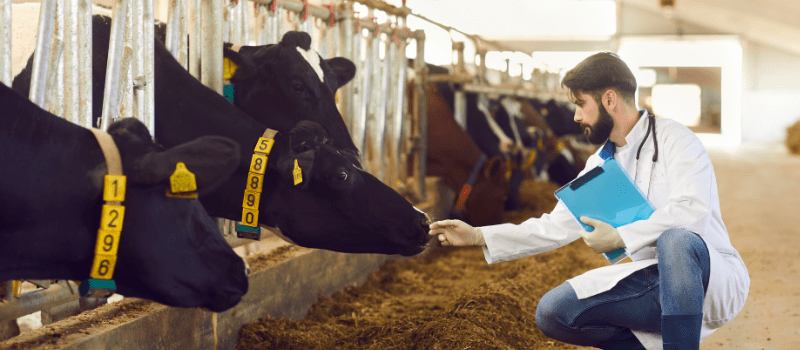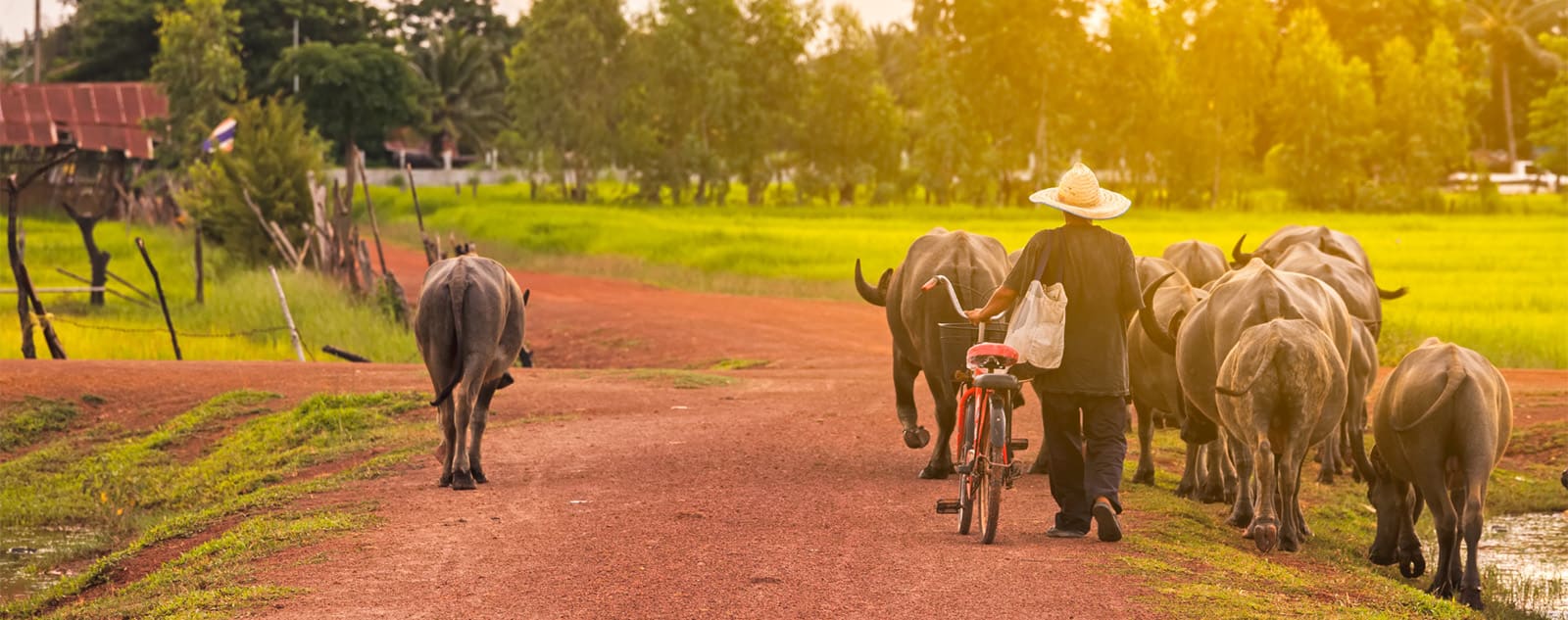Written by Tanja Kisslinger, Director of Communications, VWB. Special thanks to VWB Board Member, Dr. Anna MacKay (DVM, MSc)—former National Manager and Project Director at the Canadian Food Inspection Agency—for reviewing and providing expert insights for this article.
In a rural Kenyan village, a veterinarian kneels beside a dairy cow showing early signs of illness. Across the ocean, in a Swiss laboratory, another prepares samples to trace the source of a foodborne outbreak. Meanwhile, in the flood-prone lowlands of Laos, a third works with farming communities to adapt livestock practices to shifting climate patterns. Thousands of miles apart, their work shares a common purpose: protecting health—animal, human, and environmental.
World Veterinary Day, observed annually on April 26th, is a time to celebrate the vital contributions of veterinarians to animal health and welfare. But their role extends far beyond the clinic walls. Whether responding to disease outbreaks, improving food safety, protecting wildlife, or helping communities adapt to climate change, veterinarians around the world work at the heart of a One Health approach—recognizing the deep interconnections between human, animal, and environmental health. This article explores the broader dimensions of veterinary medicine, highlighting their impact on global health, biodiversity conservation, food safety and security, and climate change adaptation.

Supporting Farmers and Livelihoods
In many parts of the world, particularly in low- and middle-income countries, livestock are not just animals; they are assets, representing a family's livelihood, their source of income, and their social safety net. Veterinarians play a critical role in supporting small-scale farmers and pastoralists by ensuring the health and productivity of their livestock.
Healthy animals translate directly into improved household incomes. Veterinarians provide essential services like disease prevention (including zoonotic diseases) through vaccinations and parasite control, treatment of sick animals, and reproductive management, all of which contribute to increased yields of milk, meat, eggs, and other animal products. Research consistently shows that healthier livestock lead to stronger rural economies. For instance, a study published in the journal Preventive Veterinary Medicine found that targeted veterinary interventions in smallholder dairy farms in Kenya led to a significant increase in milk production and household income (Omore et al., 1999).
Furthermore, veterinarians are often the primary source of information and training for farmers on best practices in animal husbandry. They educate farmers on proper feeding practices, hygiene, and biosecurity measures, empowering them to manage their animals more effectively and sustainably. This knowledge transfer is essential for building long-term economic resilience in agricultural communities. Organizations like Veterinarians Without Borders (VWB) recognize this vital connection and prioritize training local veterinary professionals and Community Animal Health Workers to ensure sustainable access to animal health services.
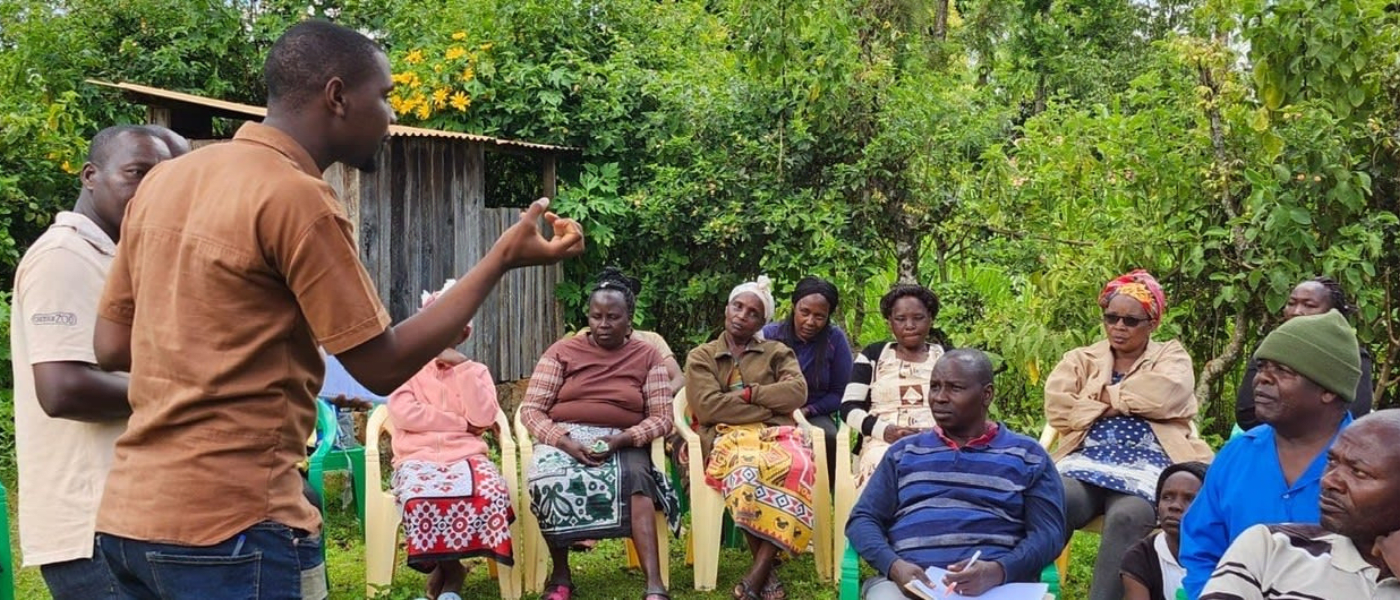 PHOTO: Dr. Muller Fotsac (DVM), a VETS program volunteer in Kenya, delivering cow feed and hygiene training to 30 dairy farmers in Matuntukine Village, Kenya.
PHOTO: Dr. Muller Fotsac (DVM), a VETS program volunteer in Kenya, delivering cow feed and hygiene training to 30 dairy farmers in Matuntukine Village, Kenya.
Protecting Wildlife and Preventing Zoonotic Spillovers
The health of domestic animals is fundamentally connected to the health of wildlife and the ecosystems they share. Outbreaks of diseases like avian influenza, for example, can begin in wild bird populations and spread rapidly to poultry farms, underscoring how deeply interconnected animal health truly is (WOAH, 2024).
Veterinarians are at the forefront of efforts to protect wildlife populations, mitigate human-wildlife conflict, and prevent the emergence and spread of zoonotic diseases. Wildlife veterinarians play a critical role in monitoring the health of wild animals, conducting disease surveillance, and treating sick or injured individuals. Their expertise is essential for addressing the growing threats to wildlife, including habitat loss, climate change, poaching, and disease outbreaks.
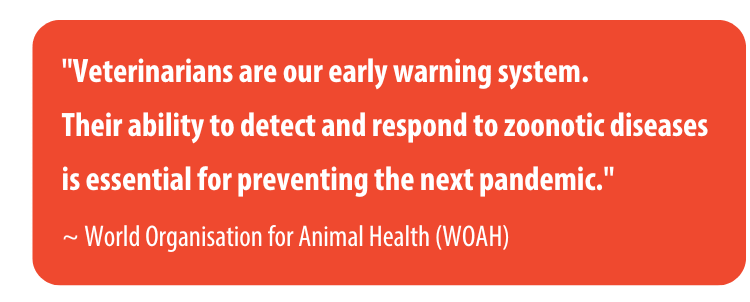 As human activity increasingly encroaches on natural habitats, the risk of human-wildlife conflict rises—resulting in livestock predation and the exchange of diseases between domestic animals and wildlife. Veterinarians help mitigate these challenges by implementing preventive measures such as vaccination campaigns, improving livestock management practices, and promoting responsible wildlife stewardship within communities.
As human activity increasingly encroaches on natural habitats, the risk of human-wildlife conflict rises—resulting in livestock predation and the exchange of diseases between domestic animals and wildlife. Veterinarians help mitigate these challenges by implementing preventive measures such as vaccination campaigns, improving livestock management practices, and promoting responsible wildlife stewardship within communities.
Zoonotic diseases—those that spread between animals and humans—pose one of the greatest threats to global public health. Veterinarians are essential to early detection, outbreak response, and disease prevention, playing a frontline role in efforts to prevent future pandemics. Their knowledge of disease ecology and epidemiology allows them to identify risk factors and develop effective control strategies. For example, veterinarians have been instrumental in controlling the spread of zoonoses like avian influenza and rabies, protecting both animal and human populations (WOAH, 2024).
Ensuring a Safe, Sustainable Food Supply
Veterinarians are essential to the safety and sustainability of our food systems. Their work spans the entire food production chain—from farm to processing plant to table—ensuring that animal-derived products like meat, milk, and eggs are safe, nutritious, and produced responsibly.
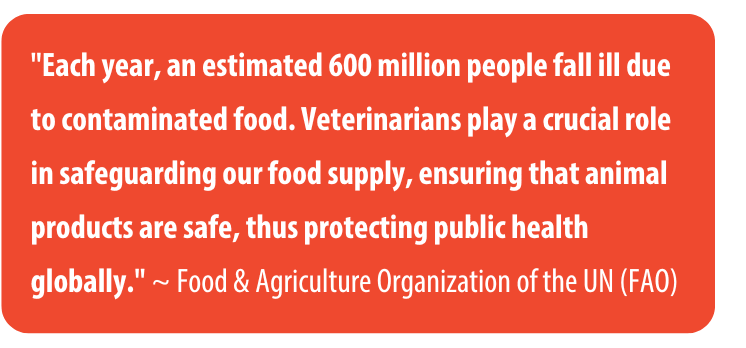 In slaughterhouses, veterinarians inspect animals to confirm they are healthy, humanely handled, and free from diseases such as bovine tuberculosis and BSE (Bovine Spongiform Encephalopathy). They also oversee hygiene and safety protocols at food processing facilities, helping to prevent contamination from pathogens like Salmonella and Listeria.
In slaughterhouses, veterinarians inspect animals to confirm they are healthy, humanely handled, and free from diseases such as bovine tuberculosis and BSE (Bovine Spongiform Encephalopathy). They also oversee hygiene and safety protocols at food processing facilities, helping to prevent contamination from pathogens like Salmonella and Listeria.
Veterinarians collaborate closely with public health agencies to monitor and respond to foodborne illness outbreaks. Their expertise is essential in tracing sources of contamination, protecting consumers, and maintaining trust in food systems.
An often overlooked aspect of food safety is antimicrobial resistance (AMR)—a growing global health threat that can emerge when antibiotics are overused in food-producing animals. Resistant bacteria can spread to people through the food chain, the environment, or direct contact with animals, making it harder to treat infections in both animals and humans. Veterinarians are on the frontlines of combating AMR by promoting responsible antibiotic use, improving disease prevention through vaccination and hygiene, and ensuring antimicrobials are used only when necessary and under veterinary supervision. According to the Food and Agriculture Organization (FAO), veterinary involvement is vital to AMR surveillance and control programs that protect both animal and human health (FAO, 2016).
By ensuring the safety and quality of animal-source foods, veterinarians contribute directly to global food security—helping to ensure that all people have access to safe, affordable, and nutritious food. Their work supports sustainable food systems and protects public health on a global scale.
Building Climate Resilience
Rising temperatures and extreme weather are reshaping animal health and production worldwide, posing significant challenges to livestock farmers and pastoralists. Veterinarians are helping communities adapt to these challenges by promoting sustainable livestock management practices and strengthening animal health systems.
Climate change can exacerbate existing animal health challenges, such as disease outbreaks and malnutrition. Veterinarians are working to improve disease surveillance and early warning systems to detect and respond to outbreaks more quickly. They are also promoting climate-smart livestock practices, such as improved grazing management, water conservation, and the use of drought-resistant breeds. These practices can help to reduce the impact of climate change on livestock production and improve the resilience of agricultural communities.
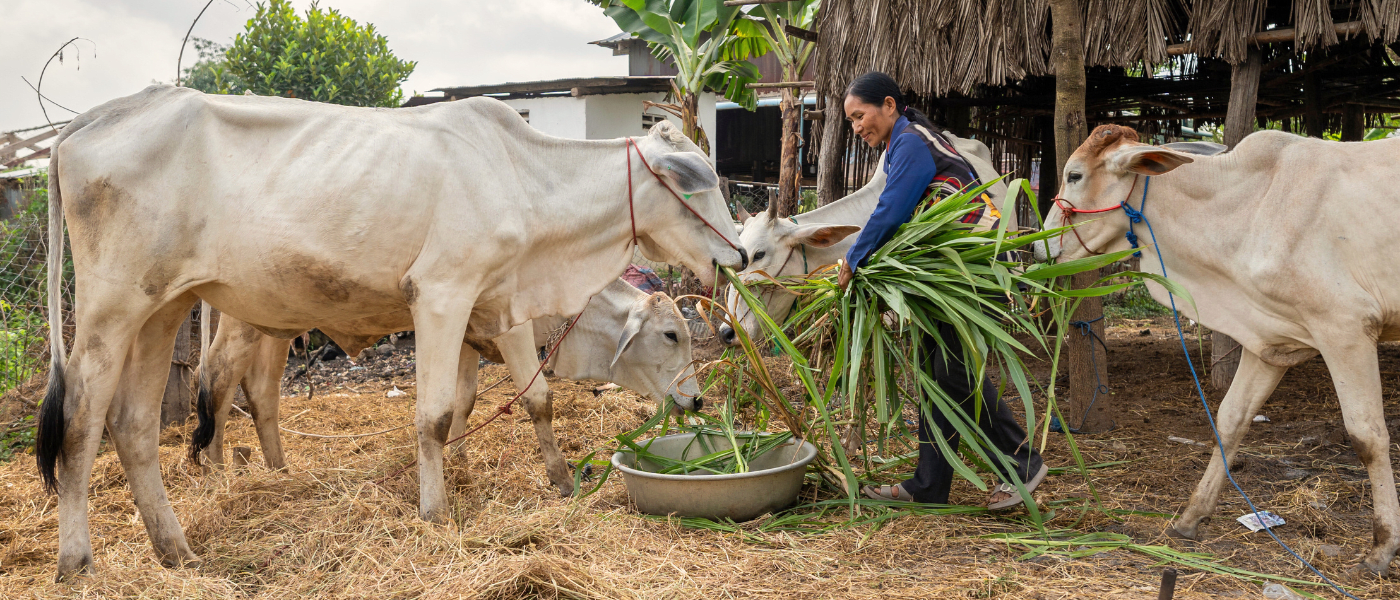 PHOTO: Ho Penh of Chamkar O Village, Cambodia, gained holistic training in livestock health, climate-smart agriculture, and One Health through VWB's AGROW program.
PHOTO: Ho Penh of Chamkar O Village, Cambodia, gained holistic training in livestock health, climate-smart agriculture, and One Health through VWB's AGROW program.
Furthermore, veterinarians are working to reduce the greenhouse gas emissions from livestock production. Livestock contribute significantly to greenhouse gas emissions, primarily through methane production from ruminant animals. Veterinarians are promoting strategies to reduce methane emissions, such as improved feed management and the use of methane inhibitors. By reducing greenhouse gas emissions from livestock, veterinarians can help to mitigate climate change and promote a more sustainable future.
A Broader Vision of Veterinary Medicine
Veterinarians are more than caregivers for animals—they are essential to global health, economic stability, and environmental resilience. Their work underpins food security, prevents disease outbreaks, and helps communities adapt to a changing climate.
As we mark World Veterinary Day, let’s recognize their expertise as a cornerstone of One Health and sustainable development. Investing in veterinary education, research, and infrastructure means investing in a healthier, more resilient future—for animals, people, and the planet.
References:
- Food and Agriculture Organization of the United Nations (FAO). (2016). The FAO action plan on antimicrobial resistance 2016-2020. Rome.
- Omore, A. O., McDermott, J. J., & Kenyanjui, M. K. (1999). The impact of veterinary clinical services on milk production and household income among smallholder dairy farmers in Kiambu District, Kenya. Preventive Veterinary Medicine, 42(3-4), 243-256.
- World Health Organization (WHO). (2023). Food safety.
- World Organisation for Animal Health (WOAH). (2024). About us.
- World Organisation for Animal Health (WOAH). (2024). Avian Influenza.
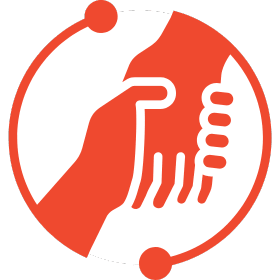 Join us in strengthening veterinary services worldwide! Healthier animals lead to stronger farms, more resilient communities, and a safer, more sustainable future. Donate, volunteer, or subscribe to support disease prevention, protect farmers’ livelihoods, and reinforce the vital connection between animal, human, and environmental health.
Join us in strengthening veterinary services worldwide! Healthier animals lead to stronger farms, more resilient communities, and a safer, more sustainable future. Donate, volunteer, or subscribe to support disease prevention, protect farmers’ livelihoods, and reinforce the vital connection between animal, human, and environmental health.

